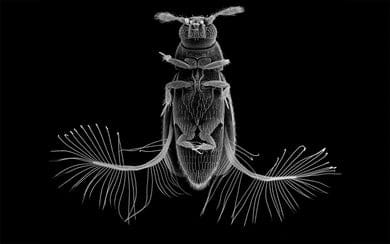
Tiny featherwing beetle uses unusual flying pattern
Recommended for Middle Grades
A featherwing beetle uses an unusual flying pattern
The tiny beetle is also known as featherwing beetle and it is half a millimetre long. It is smaller than single-celled amoebas.
What is amoeba?
An amoeba is single cell organism which has the ability to change its shape.
What is featherwing beetle?
Featherwing beetle belongs to the family of very tiny beetles. These are also called as Ptiliidae.
Scientists believed that the beetles are so tiny that they moved in the direction where the wind took them. But a new study has revealed different results.
A new study on the beetles
New research shows that the featherwing beetles use their lightweight wings to match their speed with the bigger species. The tiny beetles have wings that are light as feathers. They produce less friction which helps the beetles to help them lift in the air. The new study suggests that the tiny beetles use an unknown strategy to generate their outsized flight.
Research process
In 2017, the research team collected featherwing beetles from bits of fungi in the jungle of Vietnam. The researchers placed the creatures in a transparent chamber and filmed them with two high-speed cameras. They used the recordings to construct 3-D models of the beetle and calculated the aerodynamics.
According to the researchers, the beetles began to loop them in a certain pattern of figure eight. Scientists stated that the motion of the wings is another version of swim strokes as that of butterflies. The protective case of the wings is known as elytra and it helps to stabilize the beetle and prevent them from spinning.
![]()
There are many unique animals in the world that look and behave interestingly and differently. Have you heard about water bears or tardigrades? How about a platypus or wombat or living fossils? In fact, there are many unique, strange and rare animals that are also fascinating and amazing. Read more about such captivating creatures in our animal news for kids.
Over 500,000 children are benefitting from Curious Times today! We continue to seek your valuable feedback to serve you better. Feel free to write to us at hello@curioustimes.in.You can also follow us on WhatsApp, Instagram, Facebook Youtube, Twitter, LinkedIn.
0 (Please login to give a Curious Clap to your friend.)

